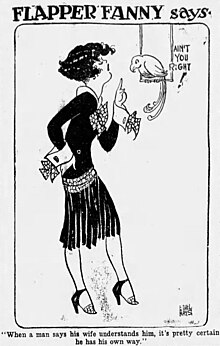| Flapper Fanny Says | |
|---|---|
 The debut panel of Flapper Fanny Says (1926): "When a man says his wife understands him, it's pretty certain he has his own way." | |
| Author(s) | Ethel Hays (1925–1930) Gladys Parker (1930–1935) Sylvia Sneidman (1935-1940) |
| Current status/schedule | Concluded single-panel daily & Sunday strip |
| Launch date | January 26, 1925 |
| End date | June 29, 1940[1] |
| Alternate name(s) | Flapper Fanny |
| Syndicate(s) | Newspaper Enterprise Association |
| Genre(s) | Humor |
Flapper Fanny Says was a single-panel daily cartoon series starting on January 26, 1925, with a Sunday page (called Flapper Fanny) following on August 7, 1932.[1] Created by Ethel Hays, each episode featured a flapper illustration and a witticism.[2] The Sunday strip concluded on December 8, 1935; the daily panel continued until June 29, 1940.[1]
At the start, the panel was drawn by notable illustrator Hays, who employed an Art Deco style. Flapper Fanny Says was part of a wave of popular culture that focused on the flapper look and lifestyle. Through many films and the works of illustrators such as Hays, John Held Jr., and Russell Patterson, as well as the writings of F. Scott Fitzgerald and Anita Loos, flappers came to be seen as attractive, reckless and independent.
When Gladys Parker took over the strip in 1930, she gave it a "more cartoony style."[3][4] Focus shifted from Fanny, now a curly-haired brunette resembling Parker herself,[5] to her little sister Betty, a schoolgirl.
- ^ a b c Holtz, Allan (2012). American Newspaper Comics: An Encyclopedic Reference Guide. Ann Arbor: The University of Michigan Press. p. 152. ISBN 9780472117567.
- ^ 100 Years of American Newspaper Comics: An Illustrated Encyclopedia, edited by Maurice Horn. New York: Gramercy Books, 1996. 413 p., ill. (some col.) -- Includes bibliographical references (p. 405-406). p. 116 ISBN 0-517-12447-5
- ^ Lambiek
- ^ Children of the Yellow Kid: the Evolution of the American Comic Strip / Robert C. Harvey (Seattle : Frye Art Museum, University of Washington Press, 1998). ISBN 0-295-97778-7, p. 58)
- ^ Robbins, Trina. The Great Women Cartoonists. New York: Watson-Guptill Publications, 2001. p. 26.